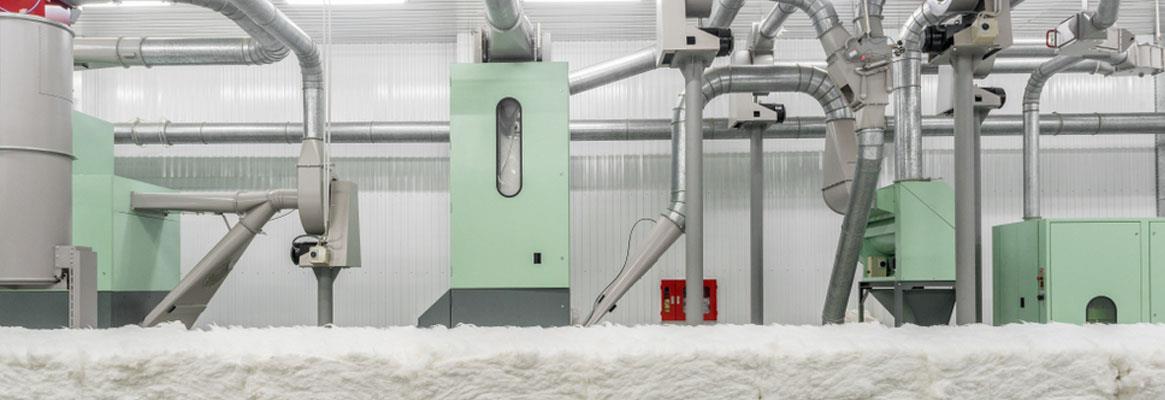Carding is known as the heart of the textile spinning mill and it is truly said that ‘well carded is half-spun’. It determines the quality of the yarn and thus the fabric. Cotton fibres are collected from the fields as tufts in bales. The fibres are converted to usable form by opening out the fibres and taking them through various operations in the spinning mills. The first step is ginning of fibres (initial opening and cleaning) followed by mixing and blending in the blowroom. The blowroom lap is fed to the card as a feed material. The fibres are further subjected to intensive cleaning and individualisation in the card. The card sliver is passed through the draw frame machine to ensure uniformity, compactness and dimensional stability. Initial twists are inserted into the draw frame sliver in the roving frame / speed frame. The final twists are imparted to the roving in the ring frame to obtain the final yarn. Removal of the maximum amount trash, dust particles, short fibres, neps and longitudinal alignment of fibres is done in the card.
Carding has the following objectives:
• Helps to separate the tufts of cotton into individual fibres
• Eliminates impurities in the range of 80-95 per cent in modern cards
• Removes dust by fibre-metal or fibre-fibre friction
• Disentanglement of neps occur mostly at card leading to opening out the mass of fibres into a thin web
• Helps to eliminate short fibres by the card clothing
• Thorough mixing of fibres occurs in transverse direction
• Partial longitudinal orientation of fibres occurs. It does not lead to complete parallelisation of fibres.
• Fibres are re-assembled into a web or sliver which is suitable for further processing.
Working regions in a card
1. Pre-opening zone (feed roller and taker-in) - The blowroom lap passes from the feed roller and taker-in under a very high draft (pressure applied causing stretching and compression of the fibres). Only about 30 per cent flocks are opened out and coarse impurities are eliminated at the taker-in.
2. Carding zone (cylinder and flats) - Separation of flocks to individual fibres is done here. Almost 75 per cent of all neps are disentangled. Dust and finer particles, very short fibres are removed. The intensity of fibre separation depends on:
• Sharpness of the clothing on the flats
• Gap between the main cylinder and flats
• Tooth density of the clothing
• Speed of the taker-in
• Speed of the doffer.
3. Transfer zone (cylinder and doffer) - Additional carding action is done here which leads to the formation of trailing hooks.
Disadvantages of the carding process
The primary disadvantages are the formation of hooks in the final transfer zone. These hooks reduce fibre length thereby creating more short fibres.
• More than 50 per cent fibres have trailing hooks
• About 15 per cent have leading hooks
• About 15 per cent have double hooks
• Less than 20 per cent do not have any hooks.
Hooks can be removed by drafting (in draw frame) and combing (comber machine).
Principles of operation of the card
The carding surfaces perform two basic actions: carding and stripping.
1. Carding action – This occurs when
a) two surfaces move in opposite directions with the wires inclined in the opposite directions.
b) two surfaces move in same directions but at different speeds.
c) its intensity depends upon
• Arrangements and density of wire points
• Setting between the wire points
• Relative surface of the clothed surfaces.
2. Stripping action – This occurs when
a) surfaces move in opposite directions
b) wires are inclined in same directions
c)surfaces move in same direction but at different speeds.
Design and working of carding machine
• The blowroom lap is the feed material for the card.
• Material is fed via a pipe duct into the feed cute of the card.
• An evenly compressed batt of about 500-900ktex is formed in the chute.
• Transport rollers forward the material to a feed arrangement that comprises of feed rollers and feed plates.
• It pushes sheet of fibres slowly into the operating range of taker-in.
• Taker-in has saw-tooth wire thoroughly combs and opens the sheet of fibres into flocks.
• Flocks pass over grid equipment and are transferred to the main cylinder.
• The impurities are recovered when material moves past the mote knives, grids, carding segments, etc.
• Suction ducts carry away the waste.
• The actual carding process takes place between the main cylinder and flats where flocks are opened into individual fibres.
• Flats consist of 80-116 individual carding bars which are combined into a band moving on an endless path.
• 30-46 bars of the flat are located in the carding position of the main cylinder.
• Flats help in removal of short fibres.
• Long fibres are continually carried along by the main cylinder as they offer more surface to the clothing of the main cylinder.
• A cleaning unit strips fibres, neps and foreign matter from the flat bars.
• Fixed clothing bars assist carding operation.
• Grids or cover plates enclose the bottom surface of the main cylinder.
• After carding the doffer carries the long fibres that lie loose and parallel without hooks onto the main cylinder.
• It combines fibres into a web form.
• A pair of rollers draw the web from the doffer.
• A pair of calendar rollers compresses the web into a sliver.
• The sliver passes through a trumpet into the nip of the coiler calendar rollers.
• The coiler calendar rollers compress the sliver and deposit it in the form of coils into a rotating cylindrical can.
These slivers are further fed into the draw frame machine. Six to eight card slivers are simultaneously fed into the draw frame machine for further compression, evenness in surface, hooks removal and fibre parallelisation.









Comments